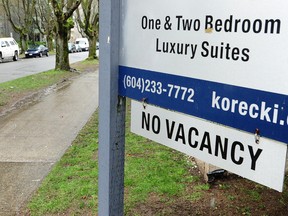New database shows rental housing completions in B.C. varies by municipality
Website lets voters compare need against completed units in their municipality

Article content
Over the past seven years, Pitt Meadows and West Vancouver built the fewest rental units per capita of all municipalities in Metro Vancouver, while the City of North Vancouver added the most.
This is the kind of information that can be pulled from a new website that lets voters compare what housing is needed with what has been approved and constructed in 160 municipalities across B.C.
“The most striking thing is that not a single municipality has been able to experience completions that come close to the need and the demand that’s out there. For me, that’s the real story of the data,” said Thom Armstrong, CEO of the Co-op Housing Federation of B.C., which joined the B.C. Non-Profit Housing Association and the Aboriginal Housing Management Association to create the website.
The groups hope information from the database will spur candidates for the municipal elections in October to sign a five-point pledge to streamline the process to build non-profit, Indigenous and co-op housing by cutting red tape and prioritizing land-use decisions as well as protect the existing supply.
The site allows users to search data from Statistics Canada and the Canada Mortgage and Housing Corporation, as well as each municipality’s own housing needs assessment. Users can compare information such as the percentage of homeowners versus renters and the number of units delivered, from market to affordable.
For instance, from 2015 to 2021, Pitt Meadows added 13 market-rental units, West Vancouver 68, and Richmond 1,008, putting them at the bottom of the list for total number of such units completed compared to the population.
The City of North Vancouver added 1,768 market-rental units, New Westminster 1,854 and Vancouver 12,750, placing them among the top three for total number of such units completed compared to the population.
But these numbers still fall short of what’s needed, observers say.
“A really significant focus of council’s time (in West Vancouver) has been looking at housing supply for workers, particularly renters, and what they’ve built in the last seven years is certainly not sufficient to tackle their workforce housing crisis,” said Jill Atkey, CEO of the B.C. Non-Profit Housing Association.
On Vancouver Island, the need for affordable housing has also been a focus of council’s attention in Duncan, where there is a homelessness crisis. Currently, 45 per cent of the population rents, while 55 per cent owns. However, over the past seven years, only one unit of market rental housing has been built.
“It’s hard from the data to understand exactly what the challenges are, but when so much of the public conversation is around housing affordability, it’s going to be surprising for residents in that community to learn how little rental development is being built,” said Atkey.
Since 2019, municipalities by law have had to complete housing needs assessments and update them every five years.
Atkey said the province is trying to determine if sufficient data is being gathered. Communities look at population growth to make projections for new homes, but this approach doesn’t allow for seeing “baked-in chronic undersupply,” she said.
She also asked if updates every five years make sense in such a dynamic housing market.
Gary Wilson, president and chair for the Aboriginal Housing Management Association, added that what the current data may not easily show is the correlation between the Indigenous populations and homelessness in those communities.
There are many communities with Indigenous overrepresentation in the population of those experiencing homelessness, but two-thirds of all municipalities don’t include data in their assessments needed for tackling the needs of urban Indigenous population, he said.
For example, in Parksville, 29 per cent of the respondents in a 2020 homeless count identified as Indigenous while Indigenous people made up just three per cent of the community’s population in the 2016 census. In Duncan, 34 per cent of the respondents in a 2020 homeless count identified as Indigenous, while Indigenous people made up 13 per cent of the community population.
Most communities only included partial data, without the kind of information that would allow for setting targets such as how many units need to be built or by when. Only Surrey, Kamloops, Powell River and Fort St. John tried to quantify the number of homes that would be needed for their urban, Indigenous populations.
“It’s a missed opportunity,” said Armstrong. “Neither the province or the vast majority of municipalities thought it was worth applying an Indigenous housing lens to housing need surveys. A land acknowledgement at the beginning of council meetings is not a housing strategy.”
More news, fewer ads: Our in-depth journalism is possible thanks to the support of our subscribers. For just $3.50 per week, you can get unlimited, ad-lite access to The Vancouver Sun, The Province, National Post and 13 other Canadian news sites. Support us by subscribing today: The Vancouver Sun | The Province.







Postmedia is committed to maintaining a lively but civil forum for discussion. Please keep comments relevant and respectful. Comments may take up to an hour to appear on the site. You will receive an email if there is a reply to your comment, an update to a thread you follow or if a user you follow comments. Visit our Community Guidelines for more information.